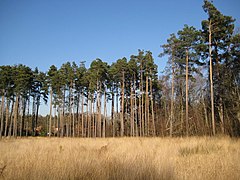Worplesdon
| Worplesdon | |
|---|---|
 Whitmoor Common, Worplesdon (part) |
|
 St Mary's Church Grade I architectural listing |
|
| Worplesdon shown within Surrey | |
| Area | 17.94 km2 (6.93 sq mi) |
| Population | 8,529 (Civil Parish 2011) 1,503 (village and closest neighbourhoods only in 2001) |
| • Density | 475/km2 (1,230/sq mi) |
| OS grid reference | SU9753 |
| Civil parish |
|
| District | |
| Shire county | |
| Region | |
| Country | England |
| Sovereign state | United Kingdom |
| Post town | Guildford |
| Postcode district | GU3 |
| Dialling code | 01483 |
| Police | Surrey |
| Fire | Surrey |
| Ambulance | South East Coast |
| EU Parliament | South East England |
| UK Parliament | |
Worplesdon is a village 3.1 miles (5.0 km) NNW of Guildford in Surrey, England and a large, quite dispersed civil parish that has the settlements of: Worplesdon itself (including its central church area, Perry Hill), Fairlands, Jacobs Well, Rydeshill and Wood Street Village, all various sized smaller settlements, well-connected by footpaths and local roads. Its area includes Whitmoor Common, which can be a collective term for all of its commons.
South of Broad Street, east of Wood Street Village on a farm in Broad Street Common are ruins of a Roman Villa – for further details see the Guildford article, as it is directly by the major town's western edge however in this parish.
Worplesdon has a Grade I C of E church, St Mary's with a 13th-century chancel and later additions. Worplesdon's single manor appears in Domesday Book of 1086 as Werpesdune held by Turald (Thorold) from Roger de Montgomery. Its domesday assets were: 6½ hides; a church, 9 ploughs, a mill worth 2s 6d, 8 acres (3.2 ha) of meadow, wood worth 60 hogs. Its 22 households (of which one was a serf's) rendered £10 sterling per year to its overlords.
Early manorial owners includes (all cited as "de..."): Basseville, Holeye, (13th century) Wykford, Wintershall/Wintershull, Seymour (14th century); Ditton, Hegham, Wykford. Then we see Jasper Tudor (Earl of Pembroke, then created the Duke of Bedford) who was attainted, however following Edward IV's grant to the Duke of Clarence in 1474, it reverted to the last Duke of Bedford of the medieval creation (who died, childless).
...
Wikipedia

